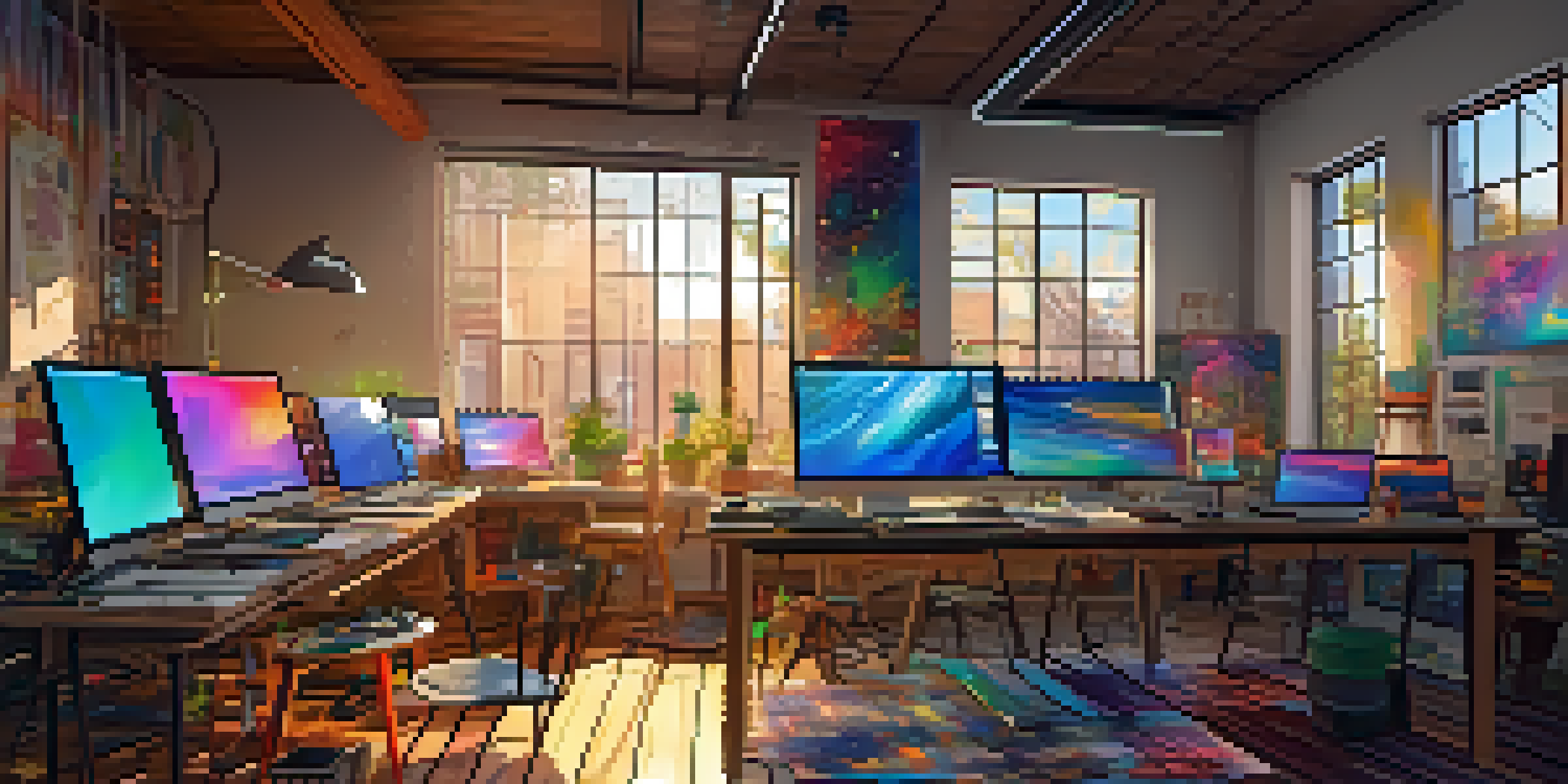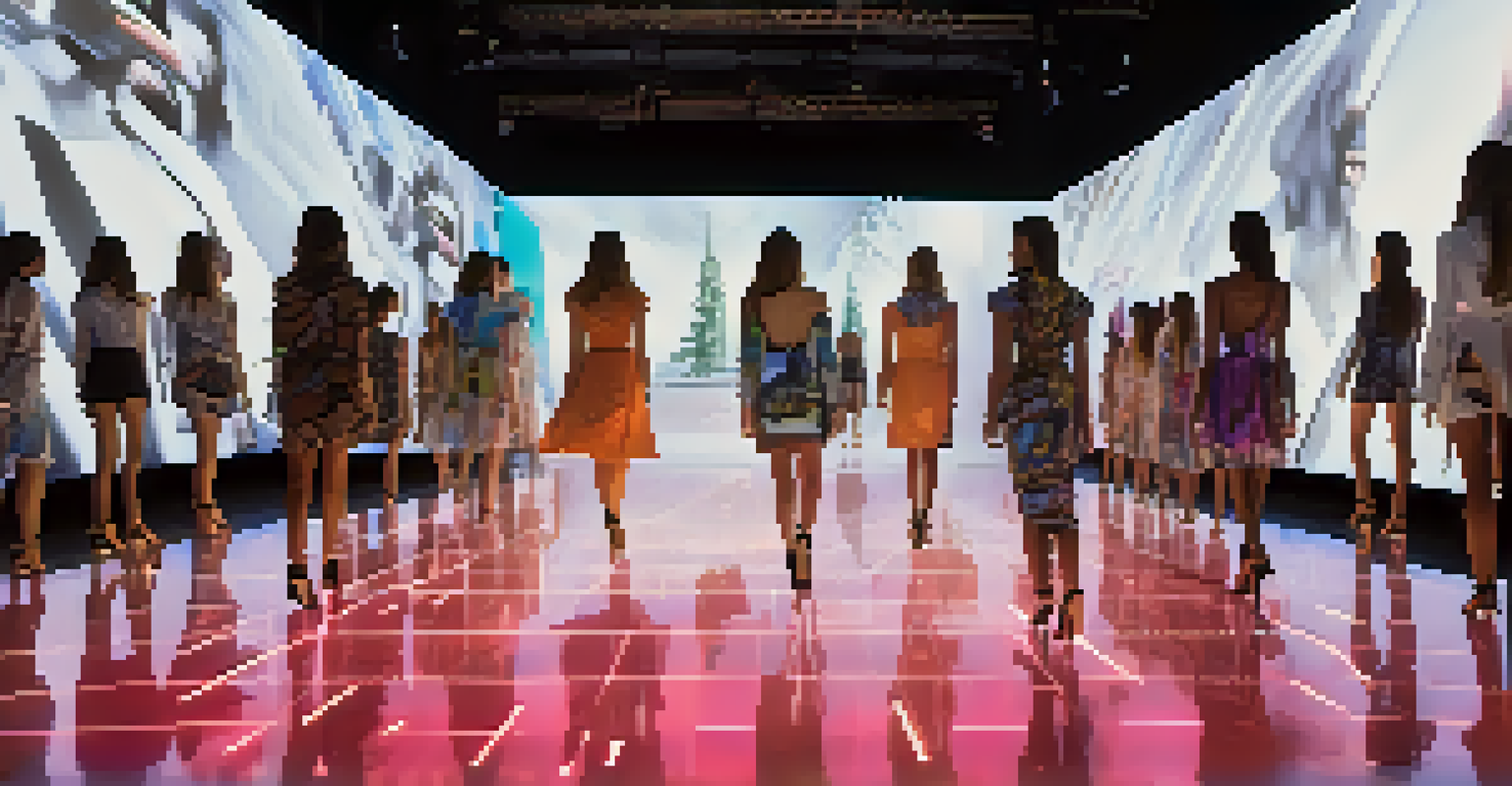The Evolution of Creative Coding: Past, Present, and Future

Understanding Creative Coding: A Definition and Overview
Creative coding is a practice that blends programming with artistic expression. It allows developers and artists to create visual and interactive experiences using code. By leveraging programming languages, creative coders can produce dynamic artworks that often respond to user interactions, making art a collaborative process.
Creativity is allowing yourself to make mistakes. Art is knowing which ones to keep.
At its core, creative coding promotes the idea that coding isn't just about functionality; it's also about creativity and exploration. This intersection fosters a unique space where technology meets artistic vision, transforming code into a medium for artistic expression. Whether it’s through generative art or interactive installations, creative coding challenges traditional boundaries.
As technology continues to evolve, so does the scope of creative coding. It invites a diverse range of people—artists, designers, and technologists—to collaborate and experiment, ultimately enriching the creative landscape. This approach not only democratizes art but also inspires innovation across various fields.
The Historical Roots of Creative Coding: A Look Back
The roots of creative coding can be traced back to the mid-20th century when early computer scientists began to explore the artistic potential of computers. Pioneers like Frieder Nake and Harold Cohen experimented with algorithms to create visually compelling art. Their work laid the groundwork for what we now recognize as creative coding.

In the 1960s and 1970s, the development of computer graphics opened new avenues for artists. Artists began using computers as tools for creating visual art, leading to a movement that combined technology with traditional artistic practices. This period marked a significant shift, as artists started to see computers not merely as machines but as creative partners.
Creative Coding Merges Art and Tech
Creative coding blends programming with artistic expression, enabling dynamic and interactive artworks that foster collaboration.
The emergence of personal computers in the 1980s further catalyzed this evolution. With accessible programming languages and software, more artists and creatives could dive into coding. The democratization of technology allowed for a broader explosion of creative coding practices, setting the stage for the vibrant community we see today.
The Present Landscape of Creative Coding: Tools and Communities
Today, creative coding is thriving, supported by a plethora of tools and platforms that cater to both novice and experienced coders. Languages like Processing, p5.js, and openFrameworks have emerged, making it easier for artists to bring their ideas to life through code. These tools often come with extensive libraries that simplify complex tasks, allowing artists to focus on their creativity.
The computer is a tool for learning and creating, a medium for artistic expression, not just a means of computation.
Communities around creative coding play a vital role in fostering collaboration and knowledge sharing. Online platforms, forums, and local meetups provide spaces for coders to connect, share their work, and learn from one another. Events like hackathons and workshops often encourage cross-disciplinary collaboration, merging technology with art in innovative ways.
The rise of social media has also amplified the visibility of creative coding projects. Artists can showcase their work to a global audience, inspiring others and creating a feedback loop that fosters further innovation. This interconnectedness has transformed how creative coding is perceived and appreciated, turning it into a vibrant and dynamic field.
Innovations in Creative Coding: Notable Projects and Artists
Innovative projects in creative coding are pushing boundaries and challenging perceptions of art. Artists like Casey Reas, one of the founders of Processing, have created works that highlight the relationship between code and art. His generative artworks often produce unique visuals that can change with each viewing, embodying the idea of art as a living entity.
Another notable figure is Zach Lieberman, known for his playful and interactive installations that engage audiences in unexpected ways. His work often blurs the line between the physical and digital worlds, inviting viewers to participate and interact. Such projects exemplify how creative coding can lead to immersive experiences that redefine audience engagement.
History of Creative Coding's Evolution
The journey of creative coding began in the mid-20th century, evolving through technological advancements that democratized art.
These artists, along with many others, exemplify the diverse possibilities within creative coding. Their projects not only showcase technical skills but also convey deeper narratives and concepts, illustrating how coding can be an expressive form of art. As these innovations continue to emerge, they inspire a new generation of creatives to explore the world of coding.
The Role of Education in Shaping Future Creative Coders
Education plays a crucial role in shaping the future of creative coding. Many educational institutions now offer courses that blend programming with art, encouraging students to explore their creative potential through coding. This interdisciplinary approach equips students with the technical skills and artistic sensibilities needed to thrive in the creative coding landscape.
Workshops and online courses have also made creative coding more accessible. Platforms like Khan Academy and Coursera provide free or low-cost opportunities for individuals to learn coding fundamentals while engaging with artistic projects. This accessibility is vital for nurturing diverse talent and breaking down barriers that might prevent aspiring creative coders from pursuing their passions.
As the demand for creative technologists grows in various industries, educational initiatives must continue to evolve. By emphasizing collaboration, experimentation, and critical thinking, educational programs can cultivate a new generation of creative coders who will drive innovation and artistic expression in the years to come.
The Future of Creative Coding: Trends and Predictions
Looking ahead, the future of creative coding is filled with exciting possibilities. As technology continues to advance, we can expect to see even more immersive experiences driven by creative coding. Virtual reality (VR) and augmented reality (AR) are likely to become significant platforms for creative coders, enabling them to create fully interactive environments that blur the line between reality and the digital realm.
Moreover, the integration of artificial intelligence (AI) in creative coding is an emerging trend that has the potential to revolutionize the field. AI can assist artists in generating content, analyzing patterns, and even creating new forms of art. This technology opens up a new frontier where humans and machines collaborate in the creative process, leading to innovative and unexpected outcomes.
Future Trends in Creative Coding
As technology advances, creative coding is set to embrace VR, AR, and AI, opening up new avenues for immersive experiences.
As we embrace these advancements, it's essential to maintain the core values of creativity and expression in coding. The future of creative coding should prioritize inclusivity and accessibility, ensuring that everyone has the opportunity to participate in this evolving landscape. By fostering a community that values diverse voices and perspectives, we can shape a future where creative coding continues to thrive.
Bridging the Gap: Creative Coding in Various Industries
Creative coding is not limited to the art world; it has begun to permeate various industries, bridging the gap between creativity and technology. For instance, in the fashion industry, designers are using coding to create interactive fashion shows that engage audiences in new ways. These innovative approaches are transforming traditional practices and opening doors to fresh possibilities.
In the realm of advertising and marketing, creative coding is being employed to develop captivating digital campaigns. Brands leverage interactive visuals and generative designs to create memorable experiences for consumers. This approach not only enhances brand engagement but also showcases the power of creative coding as a tool for storytelling.

As more industries recognize the potential of creative coding, we can expect to see its application expand further. From architecture to gaming, the fusion of creativity and technology will continue to redefine how we approach problem-solving and artistic expression across various fields.